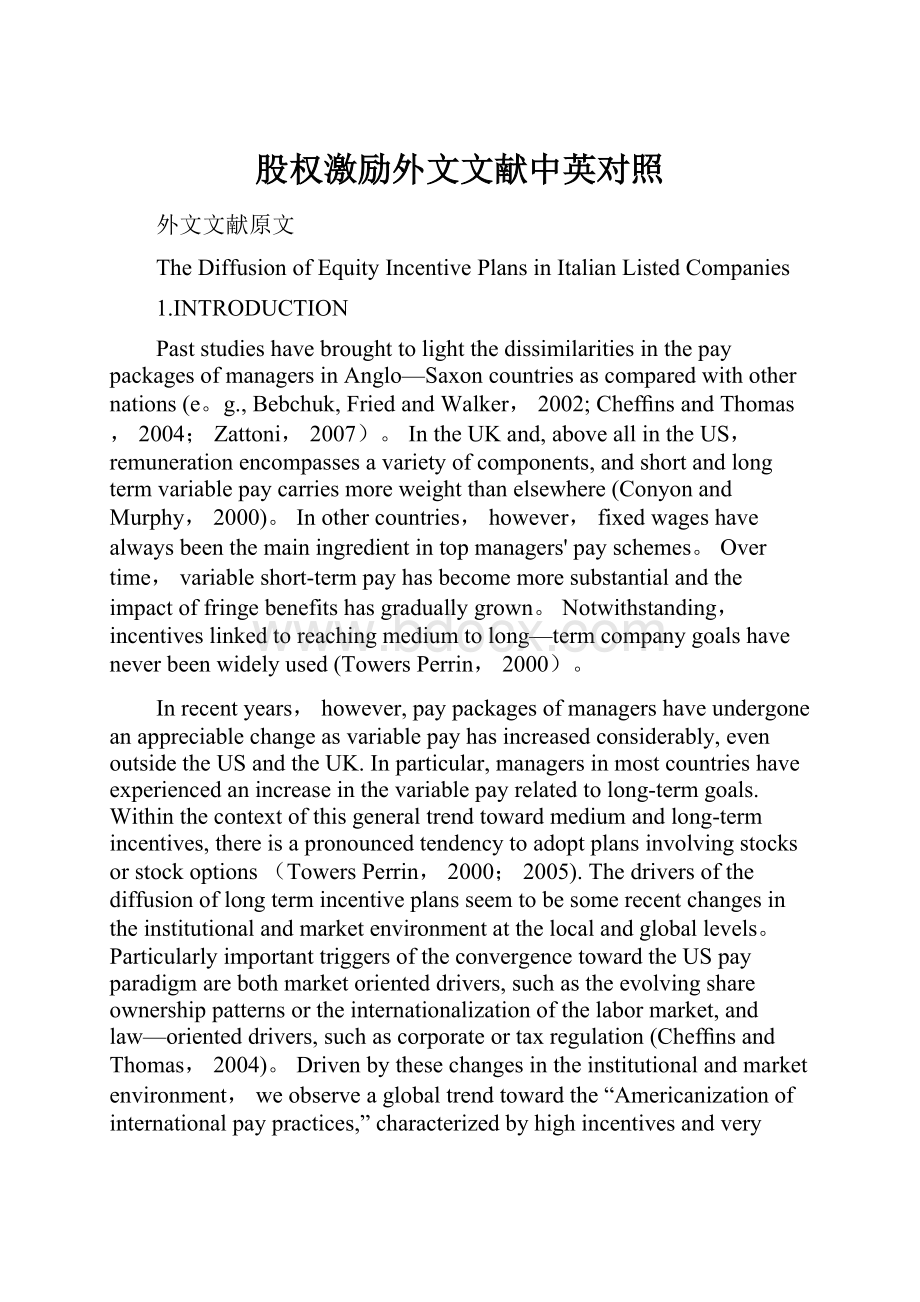股权激励外文文献中英对照.docx
《股权激励外文文献中英对照.docx》由会员分享,可在线阅读,更多相关《股权激励外文文献中英对照.docx(16页珍藏版)》请在冰豆网上搜索。

股权激励外文文献中英对照
外文文献原文
TheDiffusionofEquityIncentivePlansinItalianListedCompanies
1.INTRODUCTION
PaststudieshavebroughttolightthedissimilaritiesinthepaypackagesofmanagersinAnglo—Saxoncountriesascomparedwithothernations(e。
g.,Bebchuk,FriedandWalker,2002;CheffinsandThomas,2004;Zattoni,2007)。
IntheUKand,aboveallintheUS,remunerationencompassesavarietyofcomponents,andshortandlongtermvariablepaycarriesmoreweightthanelsewhere(ConyonandMurphy,2000)。
Inothercountries,however,fixedwageshavealwaysbeenthemainingredientintopmanagers'payschemes。
Overtime,variableshort-termpayhasbecomemoresubstantialandtheimpactoffringebenefitshasgraduallygrown。
Notwithstanding,incentiveslinkedtoreachingmediumtolong—termcompanygoalshaveneverbeenwidelyused(TowersPerrin,2000)。
Inrecentyears,however,paypackagesofmanagershaveundergoneanappreciablechangeasvariablepayhasincreasedconsiderably,evenoutsidetheUSandtheUK.Inparticular,managersinmostcountrieshaveexperiencedanincreaseinthevariablepayrelatedtolong-termgoals.Withinthecontextofthisgeneraltrendtowardmediumandlong-termincentives,thereisapronouncedtendencytoadoptplansinvolvingstocksorstockoptions(TowersPerrin,2000;2005).Thedriversofthediffusionoflongtermincentiveplansseemtobesomerecentchangesintheinstitutionalandmarketenvironmentatthelocalandgloballevels。
ParticularlyimportanttriggersoftheconvergencetowardtheUSpayparadigmarebothmarketorienteddrivers,suchastheevolvingshareownershippatternsortheinternationalizationofthelabormarket,andlaw—orienteddrivers,suchascorporateortaxregulation(CheffinsandThomas,2004)。
Drivenbythesechangesintheinstitutionalandmarketenvironment,weobserveaglobaltrendtowardthe“Americanizationofinternationalpaypractices,”characterizedbyhighincentivesandverylucrativecompensationmechanisms(e。
g。
,Cheffins,2003;CheffinsandThomas,2004).
Ironically,thespreadoftheUSpayparadigmaroundtheworldhappenswhenitishotlydebatedathome.Inparticular,thecriticsareconcernedwithboththelevelofexecutivecompensationpackagesandtheuseofequityincentiveplans(CheffinsandThomas,2004).CriticsstressedthatUStopmanagers,andparticularlytheCEOs,receiveverylucrativecompensationpackages。
The’80sand’90ssawanincreasingdisparitybetweenCEO’spayandthatofrank—and—fileworkers.Thankstothiseffect,theirdirectcompensationhasbecomeahundredtimesthatofanaverageemployee(HallandLiebman,1998).ThemaindeterminantsoftheincreasinglevelofCEOs’andexecutives’compensationareannualbonusesand,aboveall,stockoptiongrants(ConyonandMurphy,2000)。
Stockoptionplanshaverecentlybeencriticizedbyscholarsandpublicopinionbecausetheycharacteristicallyaretoogenerousandsymptomaticofamanagerialextractionofthefirm'svalue(Bebchuketal.,2002;BebchukandFried,2006).
Inlightoftheserecenteventsandoftheincreasedtendencytoadoptequityincentiveplans,thispaperaimsatunderstandingthereasonsbehindthedisseminationofstockoptionandstockgrantingplansoutsidetheUSandtheUK。
ThechoicetoinvestigatethisphenomenoninItalyreliesonthefollowingarguments。
First,thelargemajorityofpreviousstudiesanalyzetheevolutionofexecutivecompensationandequityincentiveplansintheUSand,toasmallerextent,intheUK。
Second,ownershipstructureandgovernancepracticesincontinentalEuropeancountriesaresubstantiallydifferentfromtheonesinAnglo-Saxoncountries.Third,continentalEuropeancountries,andItalyinparticular,almostignoredtheuseoftheseinstrumentsuntiltheendofthe’90s.
Ourgoalistocomparetheexplanatorypowerofthreecompetingviewsonthediffusionofequityincentiveplans:
1)theoptimalcontractingview,whichstatesthatcompensationpackagesaredesignedtominimizeagencycostsbetweenmanagersandshareholders(JensenandMurphy,1990);2)therentextractionview,whichstatesthatpowerfulinsidersmayinfluencethepayprocessfortheirownbenefit(Bebchuketal。
2002);and3)theperceived—costview(HallandMurphy,2003),whichstatesthatcompaniesmayfavorsomecompensationschemesfortheir(supposedorreal)costadvantages.
Tothispurpose,weconductedanempiricalstudyonthereasonswhyItalianlistedcompaniesadoptedequityincentiveplanssincetheendofthe’90s。
Togainadeepunderstandingofthephenomenon,wecollecteddataandinformationbothontheevolutionofthenationalinstitutionalenvironmentinthelastdecadeandonthediffusionandthecharacteristics(i.e。
,technicalaspectsandobjectives)ofequityincentiveplansadoptedbyItalianlistedcompaniesin1999and2005.Weusedbothlogitmodelsanddifference-of—meansstatisticaltechniquestoanalyzedata.Ourresultsshowthat:
1)firmsize,andnotitsownershipstructure,isadeterminantoftheadoptionoftheseinstruments;2)theseplansarenotextensivelyusedtoextractcompanyvalue,althoughafewcasessuggestthispossibility;and3)plans’characteristicsareconsistentwiththeonesdefinedbytaxlawtoreceivespecialfiscaltreatment。
Ourfindingscontributetothedevelopmentoftheliteratureonboththerationalesbehindthespreadingofequityincentiveschemesandthediffusionofnewgovernancepractices。
Theyshow,infact,thatequityincentiveplanshavebeenprimarilyadoptedtotakeadvantageoflargetaxbenefits,andthatinsomeoccasionstheymayhavebeenusedbycontrollingshareholderstoextractcompanyvalueattheexpenseofminorityshareholders.Inotherwords,ourfindingssuggestthatItalianlistedcompaniesadoptedequityincentiveplanstoperformasubtleformofdecoupling。
Ontheonehand,theydeclaredthatplanswereaimedtoalignshareholders’andmanagers’interestsandincentivevaluecreation.Ontheotherhand,thankstothelackoftransparencyandpreviousknowledgeabouttheseinstruments,companiesusedthesemechanismstotakeadvantageoftaxbenefitsandsometimesalsotodistributealargeamountofvaluetosomepowerfulindividuals.Theseresultssupportasymbolicperspectiveoncorporategovernance,accordingtowhichtheintroductionofequityincentiveplanspleasestakeholders–fortheirimplicitalignmentofinterestsandincentivetovaluecreation–withoutimplyingasubstantiveimprovementofgovernancepractices。
2。
CorporateGovernanceinItalianListedCompanies
Italiancompaniesaretraditionallycontrolledbyalargeblockholder(Zattoni,1999).Banksandotherfinancialinstitutionsdonotownlargeshareholdingsanddonotexertasignificantinfluenceongovernanceoflargecompanies,atleastasfarastheyareabletorepaytheirfinancialdebt(Bianchi,BiancoandEnriques,2001)。
Institutionalinvestorsusuallyplayamarginalrolebecauseoftheirlimitedshareholding,theirstrictconnectionswithItalianbanks,andaregulatoryenvironmentthatdoesnotofferincentivesfortheiractivism.Finally,thestockmarketisrelativelysmallandundeveloped,andthemarketforcorporatecontrolisalmostabsent(Bianco,2001).Inshort,theItaliangovernancesystemcanbedescribedasasystemof“weakmanagers,strongblockholders,andunprotectedminorityshareholders”(Melis,2000:
354).
Theboardofdirectorsistraditionallyonetier,butashareholders’generalmeetingmustappointalsoaboardofstatutoryauditorsaswellwhosemaintaskistomonitorthedirectors’performance(Melis,2000).Further,somestudiespublishedinthe’90sshowedthattheboardofdirectorswasundertherelevantinfluenceoflargeblockholders。
Bothinsideandoutsidedirectorswereinfactrelatedtocontrollingshareholdersbyfamilyorbusinessties(Melis,1999;2000;Molteni,1997).
Consistentwiththispicture,fixedwageshavebeenthemainingredientoftopmanagers’remuneration,andincentiveschemeslinkedtoreachingmediumtolongtermcompanygoalshaveneverbeenwidelyused(Melis,1999).EquityincentiveschemesadoptedbyItaliancompaniesissuestockstoallemployeesunconditionallyforthepurposeofimprovingthecompanyatmosphereandstabilizingthesharevalueontheStockExchange。
Onlyveryfewcanbecomparedwithstockoptionplansinthetruesenseoftheterm。
Eveninthiscase,however,directorsandtopmanagerswererarelyevaluatedthroughstockreturns,becauseofthesupposedlimitedabilityoftheItalianstockmarkettomeasurefirm’sperformance(Melis,1999).
3。
TheEvolutionofItalianInstitutionalContext
TheinstitutionalcontextinItalyhasevolvedradicallyinthelastdecade,creatingthepossibilityforthedisseminationofequityincentiveplans.Themainchangesregardedthedevelopmentofcommerciallaw,theintroductionandupdatingofthecodeofgoodgovernance,theissueofsomereportsencouragingtheuseofequityincentiveplans,andtheevolutionofthetaxlaw(Zattoni,2006).
Concerningthenationallawandregulations,somereformsinthecommerciallaw(1998,2003,and2005)andtheintroduction(1999)andupdate(2002)ofthenationalcodeofgoodgovernancecontributedtotheimprovementofthecorporategovernanceoflistedcompanies(Zattoni,2006).FinancialmarketsandcorporatelawreformsimprovedtheefficiencyoftheStockExchangeandcreatedaninstitutionalenvironmentmorefavorabletoinstitutionalinvestors’activism(BianchiandEnriques,2005)。
Atthesametimetheintroductionandupdateofthecodeofgoodgovernancecontributedtotheimprovementofgovernancepracticesattheboardlevel.ThesereformsdidnotproduceanimmediateeffectongovernancepracticesofItalianlistedcompanies,alt